By Jackie Freundlich McFarland
Söhnke ‘The Happy German’ Theymann
This is a tale of a faraway place where a young German has happily landed and is now spreading his wings. Many of us know the name El Campeon Farms, but may yet not know Soehnke Theymann.
 El Campeon is certainly the home of champions. The multi-faceted farm continues to host clinics, film sets and commercial shoots, and without question is one of the finest equestrian facilities in California, if not beyond.
El Campeon is certainly the home of champions. The multi-faceted farm continues to host clinics, film sets and commercial shoots, and without question is one of the finest equestrian facilities in California, if not beyond.
And now back to Soehnke (which is the English translation for Söhnke). Certainly destined for greatness, he is named after a famous German Olympic Medalist and Chef D’Equipe, Sönke Sönksen. He comes from a family with a strong equine background – his parents own a breeding farm in Dortmund, are both Grand Prix level riders and his sister has ridden on the German Dressage Team.
I was introduced to Soehnke a few seasons ago and although also from German descent (Freundlich means friendly), admittedly I had a hard time remembering this very German name. So to break the ice, I asked him how to say it and if there was another name he went by. Zunkah is how one might translate it phonetically, but to those who have gotten to know him in the show ring call him ‘the happy German’ as coined by our very own Janet Fall. And he explained that others, like Sophie and Ty Simpson, simply call him Tim.
EqSol: So you’ve been around horses all your life. What age did you start riding? Competing?
ST: Growing up on a 150-acre horse farm, there were always horses around. I was five when I started riding and was showing by age six or seven on ponies in both dressage and jumpers. I competed up to Level 5 in dressage, and rode in my first Grand Prix when I was 16. When I wasn’t competing as a junior any longer, I started to focus more on the young horses, getting our offspring ready to compete and sell.
EqSol: Did you always want to ride, teach and train?
ST: I went to school for Farm Management but then I got an unbelievable opportunity to work with Eva Gonda at El Campeon and really enjoyed it. I always had a few customer horses on the side, but now I am getting more involved in teaching. I really love the whole process of developing a horse and rider from the ground up, and customizing a training program that fits them.
EqSol: What do you see as the similarities and differences between American and German riding styles?
ST: The German style is based on dressage. Straight from the books – the classic system. The whole idea is to raise horses to jump well from a dressage background. I am also very focused on the horse’s fitness; making sure that when they start the show season they are 110% fit for the job that we are asking of them.
The American system is based in the forward seat. Riders evolve faster here – there are a lot of great trainers heavily involved in the process of the rider’s education. The process teaches riders to be very competitive in the show ring. I observed this when I came to work in West Palm Beach directly after high school. I was impressed with the style and could see that there are different ways than those I had learned to achieve top results.
EqSol: How does your German background shape your adaptation to the American system?
ST: We, the horses and the riders, strive for goals for the year and work towards that in our program – at home and at the show. We get an education every day – a lesson, flat ride or in the show ring. It’s a system we plan – it can change of course – but always looking towards the goal.
For example if we want to be competitive in the big class on Saturday, we may decide to ride the class on Wednesday slower to develop confidence for the horse. So we prepare in the previous classes to achieve the goal for that week.
EqSol: What do you see as the similarities and differences between your experience with California and German horse shows?
ST: At a number of the European shows, you trailer in, ride in four or five classes and leave that same day. I love how here you can spend the week and really gear up to your goal for that week. And there are great venues here in California – who wouldn’t love showing here?
EqSol: Going on your third year at El Campeon, what are your goals for 2010?
ST: To be as competitive as I can on El Campeon’s All Star. I brought him along from a 6 year old to the Grand Prix and at the end of last season I earned my first World Cup points on him. We will continue competing in the World Cup Qualifiers.
And to develop a nice string of competitive horses and clients at all levels. Becoming better horsemen, jumping solid rounds and achieving our goals. Of course it’s serious sport but we also have a good time.
EqSol: El Campeon is a fabulous facility – how do you take advantage of preparing for the show ring there?
ST: It’s unbelievable, the most amazing facility I’ve ever been to. From European walkers, the grass Grand Prix field, the all weather sand arena, indoor, you can’t prepare better than here – and I’ve been to good facilities. I am so very thankful to be here, you can really bring horses along here without over-showing them.
Even with the major storms that we had last week, we didn’t miss a day of training and fitness. We rode in the indoor during the downpour, but the outdoor arena was ready for riding within 12 hours after the last rain.
EqSol: So on to important things…what is your favorite American food?
ST: There are too many! Let me think… In & Out Burger – I must admit that I love that place. Also the Mexican influence, there are no Mexican restaurants in Germany. I do sometimes miss my mom’s German cooking.
EqSol: And how do you like the SoCal lifestyle?
ST: I love it. It’s laid back. People say that I don’t seem like a German because I am so laid back – so I fit right in! I think that’s why Janet called me ‘the happy German’ my first season in Thermal and it stuck. Of course I am so thankful to have this amazing opportunity – to live and work in southern California, at a facility that is second to none and with a great team of people.
Danke schön Söhnke! We always enjoy getting to know the people behind the names. Best of luck achieving your goals and continuing to live the dream at El Campeon!
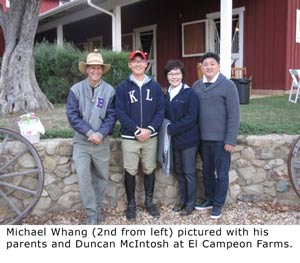 We spoke with several riders who participated at varying heights and observed Sunday’s session. Riding at the 1.20m level, Michael Whang excelled tremendously. Encouraged by his trainer Duncan McIntosh, this was Whang’s first clinic. Kenneth Vinther decided he and his young horse Cagney, who participated in the 1.30m level, couldn’t miss the chance to learn from one of the best riders in the world. Recent winner of the USHJA’s EAP National Training Session and top junior rider Ricky Neal also discussed the challenges he faced during the clinic that ultimately taught him more than the aspects that went smoothly.
We spoke with several riders who participated at varying heights and observed Sunday’s session. Riding at the 1.20m level, Michael Whang excelled tremendously. Encouraged by his trainer Duncan McIntosh, this was Whang’s first clinic. Kenneth Vinther decided he and his young horse Cagney, who participated in the 1.30m level, couldn’t miss the chance to learn from one of the best riders in the world. Recent winner of the USHJA’s EAP National Training Session and top junior rider Ricky Neal also discussed the challenges he faced during the clinic that ultimately taught him more than the aspects that went smoothly.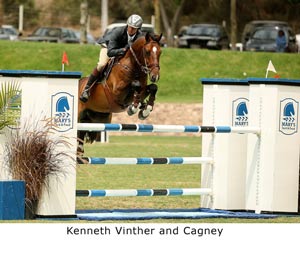 With Cagney, Vinther decided to use trot poles in front of the warm-up jump to achieve a lighter more balanced horse without pulling. Since the young jumper can get heavy, when a strong rebalancing was needed, it was encouraged as long as there was a softening. The results were nothing short of amazing; the horse is bursting with talent. He jumped around the 1.30m course beautifully. Vinther admits that he has the perfect training situation at home. His wife Karen is a dressage trainer, so when he is on the road for CWD the horse is well schooled on the flat.
With Cagney, Vinther decided to use trot poles in front of the warm-up jump to achieve a lighter more balanced horse without pulling. Since the young jumper can get heavy, when a strong rebalancing was needed, it was encouraged as long as there was a softening. The results were nothing short of amazing; the horse is bursting with talent. He jumped around the 1.30m course beautifully. Vinther admits that he has the perfect training situation at home. His wife Karen is a dressage trainer, so when he is on the road for CWD the horse is well schooled on the flat.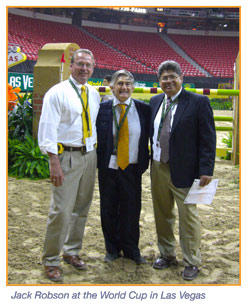 Jack Robson
Jack Robson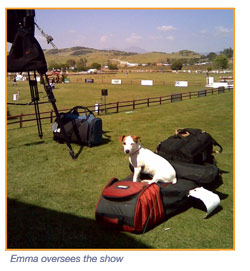 EqSol: And your future plans?
EqSol: And your future plans?
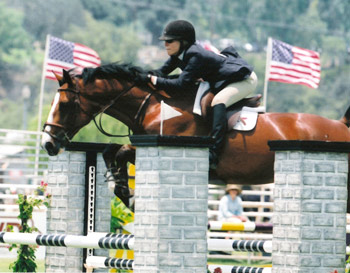 So with a clean vet check and one more test ride by the dealer (we had only tried him indoors, and wanted to make sure someone we trusted saw him jump around outdoors), we bought him. The two weeks between the time we arrived home from Europe and the time we wired the money seemed like an eternity, and he finally arrived in California during the first week of May. The day that my mom picked him up from the airport happened also to be my prom night, so I saw him for maybe five minutes before having to run off. Half of the people at our barn had already picked out his name before I even got to sit on him! Once he was mine, I absolutely fell in love with him. The first time I rode him at home, he acted wise beyond his years – didn’t spook at a single thing in our arena, essentially he behaved like a perfect gentleman. And he was super fun to ride!
So with a clean vet check and one more test ride by the dealer (we had only tried him indoors, and wanted to make sure someone we trusted saw him jump around outdoors), we bought him. The two weeks between the time we arrived home from Europe and the time we wired the money seemed like an eternity, and he finally arrived in California during the first week of May. The day that my mom picked him up from the airport happened also to be my prom night, so I saw him for maybe five minutes before having to run off. Half of the people at our barn had already picked out his name before I even got to sit on him! Once he was mine, I absolutely fell in love with him. The first time I rode him at home, he acted wise beyond his years – didn’t spook at a single thing in our arena, essentially he behaved like a perfect gentleman. And he was super fun to ride!